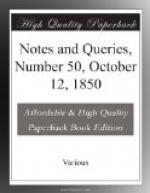1. A Bibliotheca Medico-Chirurgica et Pharmaceuto-Chemica;
2. A Bibliotheca Theologica, for Protestant theology;
3. A Bibliotheca Classica et Philologica;
4. A Bibliotheca Juridica;
and Engelmann, from time to time, numerous general catalogues;—
all of which are not only supplied to London houses, with English titles, but may be had all over Germany, with the firms of different booksellers inserted as publishers of the catalogue.
Will you make use of the above in any way in which you may think it of advantage to your readers?
ANOTHER FOREIGN BOOKSELLER.
* * * * *
CROZIER AND PASTORAL STAFF.
(Vol. ii., p. 248.)
A correspondent inquires what was the difference between a crozier and a pastoral staff. The crozier (Crocia, Mediaeval Latin), Fr. Crosse, Ital. Rocco Pastorale, German. Bischofstab, is the ornamental staff used by archbishops and legates, and derives its name from the cross which surmounts it. A crozier behind a pall is borne on the primatial arms of Canterbury. The use of the crozier can only be traced back to the 12th century. Cavendish mentions “two great crosses of silver, whereof one of them was for his archbishoprick and the other for his legatry, always before” Cardinal Wolsey. The fact did not escape Master Roy, who sings thus:—
“Before him rydeth two Prestes stronge,
And they beare two Crosses right longe,
Gapinge in every man’s
face.”
Hall says that he removed from Whitehall “with one cross.” In the Eastern Church patriarchs only have a crozier; a patriarch has two transverse bars upon his crozier, the Pope carries three.
The pastoral staff was the ensign of bishops. Honorius describes it as in the form of a shepherd’s crook, made of wood or bone, united by a ball of gold or crystal, the lower part of the staff being pointed.
“In Evangelio Dominus Apostolis praecepit, ut in praedcatione nihil praeter virgam tollerent. Et quia Episcopi pastores gregis Dominici sunt, ideo baculum in custodia praeferunt: per baculum, quo infirmi sustentatur, auctoritas doctrinae designatur; per virgam, qua improbi emendantur, potestas regiminis figuratur. Baculum ergo Pontifices portant, ut infirmos in Fide per doctrinam erigant. Virgam bajulant, ut per potestatem inquietos corrigant: quae virga vel baculus est recurvus, ut aberrantes a grege docendo ad poenitetiam trabat; in extremo est acutus, ut rebelles excommunicando retrudat; haereticos, velut lupos, ab ovili Christi potestative exterreat.”—In Gemma Animae, lib. i. cap. 218, 219., apud Hitterpium.
In its primitive form it appears to have been a staff shaped like a T, and used to lean upon. It was gradually lengthened, and in some cases was finished at the top like a mace. The pastoral staff is mentioned in the Life of S. Caesarius of Arles. Gough says that the pastoral staff found in the coffin of Grostete, Bp. of Lincoln, who died in 1254, was made of red wood ending in a rudely shaped ram’s horn. It was inscribed:




